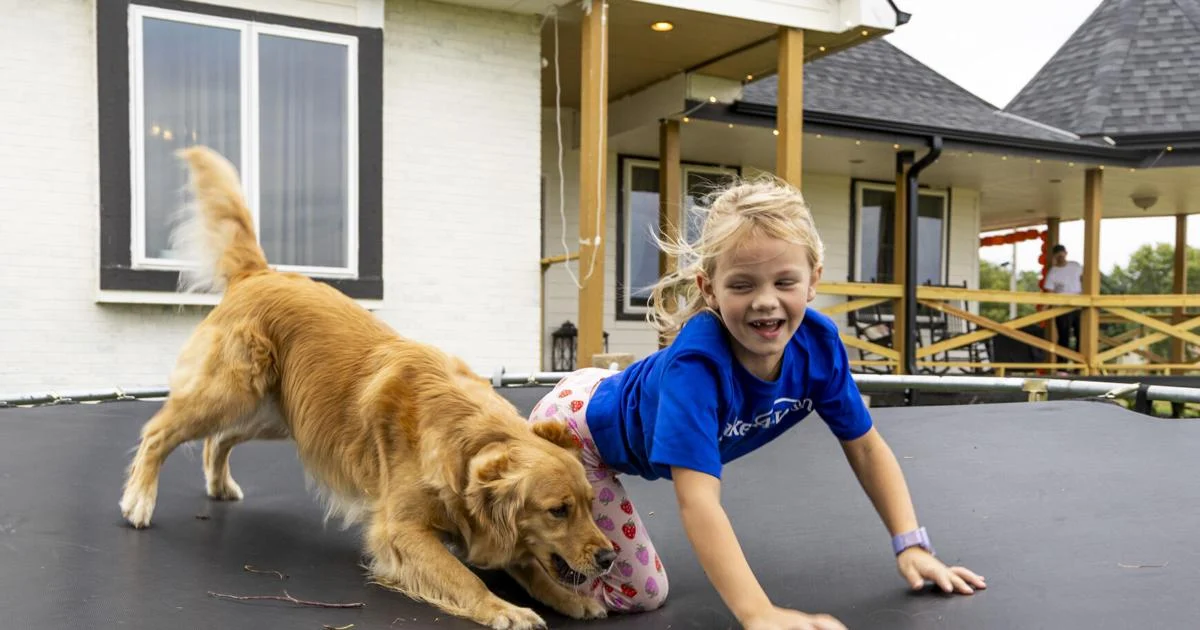
VALPARIASO — Her eyes grew distant. Her soft voice was slurred and broken as tears threatened to fall down her cheeks.
Gracie Wolfe was visibly scared and confused, fighting to form words she couldn’t find, breathing rigidly as she lay on the couch staring up at her parents.
The 6-year-old from Valparaiso, about 30 miles north of Lincoln, was in the midst of a focal aware seizure, meaning she was still conscious while seizing.
“Everything is OK, it’s just fine. We’re just hanging out relaxing,” her dad, Jamison Wolfe, cooed softly at her. “I know you’re trying to fight it and it’s really tough, but you’re doing a really good job. You really are doing a fantastic job.”
“Can you hear mom and dad? You’re having a seizure, Gracie. But it’s OK,” her mom, Tes Wolfe, gently chimed in. “You’ve been doing really good, even if it’s tough.”
“Her face looks a little blue,” Tes whispered to her husband. “Gracie, I think we should put some oxygen on ya.”
The little girl stared up at her parents with wide, panic-stricken eyes, trying to stop the seizure that would last 40 minutes with pure stubbornness.
But the seizure, documented in a video posted to TikTok last month, wasn’t anything out of the ordinary for the Raymond Central first grader.
Gracie has Dravet syndrome, a rare form of “severe, catastrophic” epilepsy that typically begins in infancy and can cause prolonged and frequent seizures, most of which are silent and hard to detect. While it’s typically diagnosed early in a person’s life, it isn’t something the young Nebraska native will outgrow.
It’s a lifelong disease.
In her short life, Gracie has taken countless ambulance rides, been to numerous hospital visits and been poked and prodded more times than she can count. She has fought seizures on the side of the highway, on the beaches of Cancun, at her desk in school and while watching fireworks on the Fourth of July.
“It’s really scary,” Gracie said.
But Tes Wolfe hopes to uplift her daughter and other Dravet syndrome patients by spreading awareness on TikTok, giving millions of people across the world an inside look into what living with Dravet syndrome is like.
“It’s a wild life,” Tes Wolfe said.
The first seizure
Life with Gracie before seizures was short-lived.
Her first episode came when she was just 1. It was sudden, unexpected, terrifying.
“I was screaming bloody murder at the top of my lungs, pretty sure I’ve just lost my kid,” Tes Wolfe said of the moment in March 2020 when she discovered her youngest daughter seizing.
“I was downstairs when it started, but I could hear the screaming. You just know, and I just knew,” Jamison Wolfe added.
After 25 minutes, the seizure stopped and everything seemingly went back to normal. It was probably just some absurd side effect caused by the fever she had at the time, they thought.
But two months later, a second seizure followed.
EMTs filled their house, hooking the small toddler wearing nothing but a diaper up to machines and prepping needles full of medicine to stop the seizure. At the hospital, Gracie was hooked up to even more monitors — she was a child covered in cords in an oversized hospital bed.
From there, the Wolfe family embarked on a journey searching for answers. It might be epilepsy, they were told. Probably nothing out of the ordinary. Probably something they can manage with medicine.
Then came the diagnosis.
“She has Dravet syndrome,” a neurologist explained to Tes Wolfe over the phone, leaving her breathless.
It’s resistant to medication, they were told. The seizures are silent and long, lasting up to 50 minutes — 48 minutes longer than a typical seizure. The disease will change and adapt as she grows, sometimes getting better and sometimes getting worse. It’ll likely cause developmental delays, behavioral issues and motor skill deficiencies. Treatment options are limited.
And it’s rare.
Researchers believe only 1 in 15,700 to 40,000 people in the United States have Dravet syndrome. Of the 26,000 Nebraskans living with epilepsy, only a fraction have the disease.
Dravet syndrome is caused by an underlying gene mutation that disrupts the way the cells in the brain communicate, according to the Dravet Syndrome Foundation. Because of this, there is no cure.
It was a lot to take in at once, Tes Wolfe said.
“I probably spent every hour of the next two weeks Googling every option,” she said.
In the years since her diagnosis, Gracie has grown into her bold personality, but living with Dravet syndrome has never gotten easier. She was later diagnosed with autism and ADHD. She has trouble sleeping at night and struggles with focusing.
The Wolfe family has had some really great days — like those spent rollerskating around the neighborhood or swimming in the Gulf of Mexico. But they’ve also had some really hard days. Days spent on the side of highways in the pouring rain as Gracie seized.
Days spent in hospital rooms. Days spent praying for a miracle.
But those bad, really hard days have helped them learn what Gracie needs in those vulnerable scary moments.
They now keep a stockpile of oxygen tanks in their house just in case, and Gracie sleeps with a medical-grade pulse oximeter to monitor her oxygen levels in case a seizure comes while she’s asleep.
The Wolfes got good at tracking her seizures and knowing what to do when one started.
But in June, they changed.
Growing, changing seizures
Gracie’s seizures used to be sporadic, usually occurring weeks or months apart and were more similar to tonic-clonic, or grand mal, seizures, which are typically experienced by generalized epilepsy patients.
In June, however, they changed.
Listen now and subscribe: Apple Podcasts | Spotify | RSS Feed | SoundStack | All Of Our Podcasts
The seizures became focal aware, meaning Wolfe is conscious and alert during the seizure, even if she doesn’t remember anything after. And a new pattern popped up: Excitement. Anytime Gracie got overly excited about something, a seizure would happen.
The Wolfes welcomed several new chickens to their coop. Later that day, she had a seizure.
Gracie was set to have her first-ever sleepover with her best friend. Then, she had a seizure.
She went to a friend’s birthday party. Seizure.
As soon as she saw the ocean for the first time. Seizure.
Fourth of July fireworks. Seizure.
They’ve become more frequent, too. And the location of the seizures in her brain appears to be changing, as well.
The Wolfes are working to decipher where exactly in the brain Gracie’s seizures are occurring based on where her eyes look during an episode. Because her eyes often switch from looking to the left to the right, they believe the seizures may even be jumping between the brain’s hemispheres.
In order to know for sure, they have to catch an active seizure on an EEG, which requires perfect timing — what feels like an almost impossible task.
From there, they could explore more invasive treatment plans, like a vagus nerve stimulator, an implanted device that helps prevent seizures by sending electrical impulses via the vagus nerve in the neck, or even a Responsive Neurostimulation system, which serves the same purpose but would instead be inserted onto the brain.
For now, Gracie uses an Apple Watch to monitor her heart rate and look for signs of an active seizure. If the watch detects she may be seizing, an app automatically calls her parents to alert them to a potential seizure.
She also has a seizure-alert dog, Addie, who is still in training and has successfully alerted to four seizures so far.
It’s tough, but they manage — especially with the help of their two oldest children, Lexi, 10, and Jackson, 9, who have begun helping their parents during the seizures.
“We are a team. We need them. They are important to this. They help ensure the safety of Gracie, so they’re active members of the team,” Jamison Wolfe said.
Reaching millions worldwide
Tes Wolfe lives her life in motion.
Between caring for her children, she chases multiple cats, two dogs and a coop full of chickens around the backyard.
She’s also a caregiver for a woman named Ardyce, who lives in their home full time.
Tes Wolfe has even been working to train Addie to alert to Gracie’s seizures.
But now, she’s adding one more task to her plate: spreading awareness about her daughter’s rare disease.
“I’m big on advocating for hard things,” she said.
Through her TikTok account (@teswolfe), Tes Wolfe has shared multiple videos of her daughter’s seizures in an attempt to inform viewers of what Dravet syndrome looks like and how it can affect her daughter’s life.
In August, a video reached nearly 800,000 views and 75,000 likes. A few days later, another post garnered 590,000 likes and 4.1 million views.
The 4,000 commenters came from across the country and world, some even reaching out from as far away as Germany, Paris, Australia and the United Kingdom.
Teachers thanked her for spreading awareness about a disease they had never heard of. Others offered advice or encouraging notes. One parent said she was able to finally identify what kind of seizures their son was having because of the videos.
“Just that, makes the whole video worth it,” Jamison Wolfe said.
For such a rare disease, the advocacy Tes is providing is priceless, according to Samantha Tena-Morales, the executive director of the Epilepsy Foundation of the Great Plains.
“People who are seeing Tes’s story about her daughter, Gracie, online, they’re getting exposed to something that they had never experienced before,” she said. “ And it’s helping spread awareness for other families that feel like they’re alone in this, and other people that are interested, and other people that might be exposed later on in their lives.”
‘Crazy Gracie’
Gracie runs around the house, jumping on couches and zooming through an obstacle course of orange cats and golden retrievers, her bleach-blond hair billowing wildly across her face.
On the trampoline outside of their Valparaiso home, she practices front flips while her seizure alert dog, Addie, jumps alongside her. Soon, she’s climbing up a tree, dangling upside down, before running back inside.
She has cut her own hair — twice — and laughs loudly any chance she can get. Gracie loves the Netflix movie “KPop Demon Hunters,” Elsa from “Frozen” and living life in her naturally free-spirited way.
She has no limits. She’s like a “tornado.” She’s “Crazy Gracie,” as her family lovingly calls her — a nickname she embraces proudly.
The seizures have never slowed her down.
“She’s indestructible,” Jamison Wolfe said.
Soon, Gracie will have a wish come true through the Make-A-Wish Foundation, which she recently qualified for. Right now, she’s thinking a trip to Disney World to see Elsa sounds pretty nice.
But the foundation is just the latest group to provide support and love to the entire Wolfe family.
The people of Valparaiso have shown up for the family of five time and time again. Their support has been unwavering since the start.
When Gracie was having a seizure but they couldn’t get a call through to 911, a neighbor directly called the fire chief to get an ambulance to their house. When Gracie needed a seizure alert dog, the community of nearly 600 people hosted multiple fundraising events to help reach her goal.
And the selflessness and care shown by the local emergency responders has been instrumental in ensuring Gracie’s safety during a seizure.
Said Jamison Wolfe: “This village is very important to us.”
Reach Jenna Ebbers at 402-473-2657 or jebbers@journalstar.com.
Love
0
Funny
0
Wow
0
Sad
0
Angry
0
Get local news delivered to your inbox!
Subscribe to our Daily Headlines newsletter.
* I understand and agree that registration on or use of this site constitutes agreement to its user agreement and privacy policy.
Jenna Ebbers
K-12 education reporter
Get email notifications on {{subject}} daily!
Your notification has been saved.
There was a problem saving your notification.
{{description}}
Email notifications are only sent once a day, and only if there are new matching items.
Followed notifications
Please log in to use this feature
Log In
Don’t have an account? Sign Up Today



